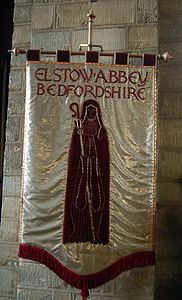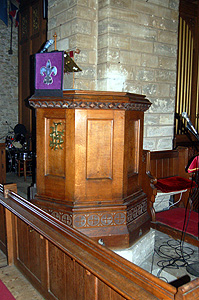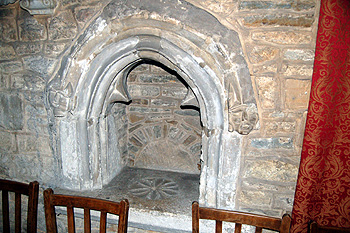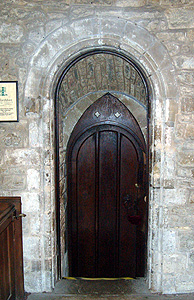List of Elstow Vicars

The parish vexillum February 2012
Advowson
Volume III of The Victoria County History for Bedfordshire was published in 1912. It noted that the advowson of the church was always owned by the Lord of the Manor of Elstow. Thus until 1539 it was in the hands of Elstow Abbey and in the early 20th century the patrons of the living were the Whitbread family.
Technically speaking the vicars were actually perpetual curates because the abbey had held both the offices of rector and vicar. At the time of writing the patrons of the living are the Elstow Patronage Board.
In 2004 the Elstow Team Ministry was created. It comprises Bedford, Saint Michael and All Angels and Cardington as well as Elstow. Each church retains its own parochial church council and church officers as well as its own dedicated priest who is part of the team.

The pulpit February 2012
List of Vicars/Perpetual Curates
The following list of Vicars of Elstow is as complete as records will allow. Interestingly there seem to have been two curates at the same time from at least 1235 to at least 1342.
- Henry: chaplain;
- Roger de Weseham; in succession to Henry the chaplain: 1222;
- Haumon de Weseham, chaplain: in succession to Roger de Weseham: 1235;
- Simon de Elnestowe;
- Alexander de Elnestowe; to a portion of Church in succession to Simon de Elnestowe: 1235;
- John de Elnestowe, subdeacon; to a portion of church in succession to Alexander, his brother: 1247;
- John, chaplain; on death of Hamon [de Weseham]: 1259;
- Richard de Salested;
- Richard Scot, chaplain; to part of church on the death of Richard de Salested: 21st March 1274;
- Matthew de Dunstaple, subdeacon; to part of the church on the death of Richard Scot: 17th October 1275;
- Robert de Welye, clerk in minor orders; to part of the church on the death of Matthew de Dunstaple: 23rd September 1284;
- Hugh de Suthluffenham, chaplain; to part of the church on the death of Robert de Welye: 25th May 1311;
- Thomas de Baumbergh, acolyte; to part of the church on the death of Robert de Welye: 26th September 1317;
- William Fincayl, deacon; to part of the church on the death of Hugh de Luffenham: 5th May 1318;
- John de Felmersham, acolyte; to part of the church on the resignation of William Synkal; 1st August 1324;
- William de Tykhull; to part of the church on the resignation of Thomas de Baumburgh: 5th May 1325;
- Robert le Spicer, of Farendon [probably Faringdon in Oxfordshire]; to part of the church on the resignation of William de Tekhill: 24th June 1335;
- Hugh de Estmarcham, Rector of Bradested [?], to part of the church by exchange with Robert le Spicer de Farendon: 27th March 1336;
- Adam de Brandon, priest; to part of the church on the resignation of Hugh: 12th October 1339;
- Nicholas Holham, priest; to part of the church on the resignation of Adam de Brandon: 7th December 1340;
- John Bachelor;
- Robert de la Beche, priest; to part of the church on the resignation of John Bachelor: 26th May 1342;
- John Kyng, curate: 1526;
- Thomas Blocksley, curate;
- Robert Hundley, M.A., curate: 1605;
- Robert Twisden: 1612;
- Henry Bird: 1617;
- John Bellay, clerk: 1623;
- Andrew Cater, clerk; married Mrs. Alice Clarke at Old Warden on 21st Mar 1659: 1650s;
- Christopher Hall: buried 26th May 1666: 1660s;
- David Jerland: buried 9th June 1668: 1660s;
- Longhorne: 1668;
- John Robinson: 1686;
- William Hobbs: 1696;
- John Towersey: 1707;
- Thomas Aubrey: 1715;
- Robert Phipp;
- John Smith, clerk, on the death of Robert Phipp: 31st October 1782;
- Thomas Cave, clerk; on the death of John Smith: 25th April 1806;
- George Hull Bowers, clerk; on the death of Thomas Cave: 5th June 1819;
- John Wing, clerk; on the cessation of G H Bowers: 1st May 1832;
- John Gaskin M. A.; on the cessation of John Wing: 2nd February 1849;
- John Henry Augustus Rudd B. A.; on the death of John Gaskin; resigned 15th October 1867: 29th July 1852;
- James Copner M. A.; on the resignation of J.H.A. Rudd: 4th December 1867;
- George Parker: April 1896;
- Charles Frederick Bonney Hawkins: January 1905;
- Stanley Victor Hartley: 1920;
- Peter Goodwin Hartley: 1953;
- Michael James Murfin Norton: 1976;
- John Andrew Tibbs: 1983;
- Richard William Huband: 1991;
- Jeremy R. Crocker: 2004.
Visitations
Volume 81 published by the Bedfordshire Historical Records Society (2002) is devoted to returns made during the episcopal visitations to the county by the Bishop of Lincoln in the early 18th century, edited by former County Archivist Patricia Bell. It throws some interesting light on non-residency and the general state of the church in the parish. At this date it was common for a rector or vicar to not live in the parish he nominally served, often because he had more than one, and so employed a curate to undertake their parochial duties for him. The returns for Elstow, where ther was no house for him to live in, are as follows:
- 1706: the vicar wrote: “A Curacy, Mr. William Hobbs Curate. Both Rectory and Vicarege were before the Reformation appropriated to a Nunnery, then scituate in this place, and at the dissolution of the Monasteries alienated into Lay hands. It is supposed that no Person has for many years had Institution to it … There is no Minister’s House, nor has he right so much as to the Churchyard. All he can claim is a stipend of £8 a year payable out of some rents belonging to the Crown, and the charges of receiving that are 12s. per Annum”.
- 1709: “One woman, an Anabaptist, baptized since my last Visitation. None Unbaptized come to Church: severall not confirmed”.
- 1712: “The Curate, having no House, lives about halfe a mile out of the Town. Five Adults baptized since my Visitation. Two others Unbaptized come to church, one of which is now preparing for Baptism. Some not confirmed. Divine Service twice every Lord’s day, once every Litany and Holy-day … Communion 4 times a year. Communicants 54: at Easter 40 received”.
- 1717: “There is no parsonage-house … There are none who come to church but what are baptized, but several who have not been confirmed. I have baptized one Adult (viz) Susanna Farrow August 10th 1715” … The publick Service is read twice every Lord’s day … The sacrament of the Lord’s Supper is administered four times in the year. The number of communicants was at Easter last thirty eight”.

Piscina in the south aisle February 2012
Ecclesiastical Census
On Sunday 30th March 1851 a census of all churches, chapels and preaching-houses of every denomination was undertaken in England and Wales. The local results were published by Bedfordshire Historical Records Society in 1975 as Volume 54, edited by D. W. Bushby. The return for church was made by the vicar, John Gaskin, who noted the following pieces of information:
- 130 free sittings; 30 other;
- 63 general congregation and 39 Sunday scholars in the morning;
- 150 general congregation and 39 Sunday scholars in the afternoon;
- The average was 80 general congregation and 48 Sunday scholars in the morning with 160 general congregation and 48 Sunday scholars in the afternoon;
- “Church is spacious and admits of benches being placed for accommodation to a large extent”.

Doorway to the vestry from the south aisle February 2012